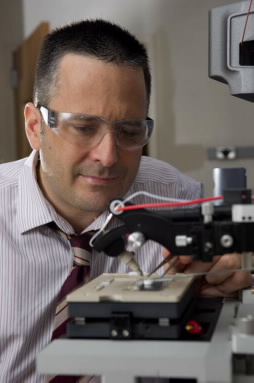EMBARGOED FOR RELEASE | August 19, 2012
New technology combats global pandemic of drug counterfeiting
Note to journalists: Please report that this research was presented at a meeting of the American Chemical Society.
PHILADELPHIA, Aug. 19, 2012 — Drug counterfeiting is so common in some developing countries that patients with serious diseases in Southeast Asia and elsewhere are at risk of getting a poor-quality drug instead of one with ingredients that really treat their illness, a scientist involved in combating the problem said here today.
Speaking at the 244th National Meeting & Exposition of the American Chemical Society, the world’s largest scientific society, Facundo M. FernÁndez, Ph.D., described how his team has developed technology that reduces the time needed to check a sample for authenticity from a half hour to a few minutes. And they are working on the prototype of an affordable, portable version of the device that could be used in the field.
Media Contact
During Aug. 17-23 the contacts can be reached at 215-418-2086.
Michael Bernstein
202-872-6042
m_bernstein@acs.org
Michael Woods
202-872-6293
m_woods@acs.org
“It would enable medical officials in developing countries to check on whether a drug for malaria, tuberculosis or other diseases is the real thing, or a fake that contains no active ingredients, or the wrong one,” FernÁndez explained. “They could sort the good medicine from the bad immediately, without shipping samples to laboratories abroad and waiting days or weeks for the results.”
FernÁndez, who is with the Georgia Institute of Technology in Atlanta, said new ways of fingering fake medicines are important because the problem is spreading with the globalization of pharmaceutical production ― almost like a global pandemic ― with drug counterfeiters becoming more sophisticated.
“In some of our studies, 50 percent of the drug samples from Southeast Asia have been counterfeit,” FernÁndez said. “And it is hard to tell from looking at the packaging. The packages look absolutely professional and authentic, sometimes right down to the hologram seal introduced to discourage counterfeiting.”
Counterfeiting involves all kinds of medications, from the acetaminophen used for headaches and fever (see separate press release) to lifestyle medications like Viagra to drugs for cancer, malaria and tuberculosis, diseases that cause millions of deaths annually. The World Health Organization says that about 10 percent of medications worldwide are counterfeit. Estimates run even higher in poor, developing countries in Southeast Asia and Africa, where past reports have stated that as much as one-third of tested drugs are fake. Patients in these countries often cannot afford the real treatments, and supplies of the real drugs may run dangerously low in some regions, prompting desperate patients to seek medications from shady sources.
Fake medications sometimes contain the correct active ingredient, but at the wrong dose. Too much could result in an overdose and possibly death. Too little could result in drug resistance, leading to a situation where the real medication doesn’t even work anymore. Other counterfeit drugs do not contain the active ingredient at all. Still others contain toxic substances or even different drugs that could cause unexpected side effects or allergic reactions.
FernÁndez and colleagues developed methods to finger fake anti-malarials and tuberculosis medicines and identify their ingredients. The team also distinguishes between counterfeits and drugs that may just have degraded after exposure to hot and humid conditions and those that are just not made correctly at the manufacturing plant. To do this, they use mass spectrometry (MS), a standard laboratory technology that weighs molecules in order to identify them.
“So-called ambient MS methods require much less instrument and personnel time than traditional methods, so we use them as a first pass to look at the quality of large sample sets,” said FernÁndez. For example, the researchers recently tested 900 samples from Cambodia in only two weeks with their rapid MS technique. This would have taken months with traditional approaches. “Suspicious samples would then be re-examined by more complex and costly techniques,” he added.
His group identified several counterfeit anti-malarial medications in a recent study in which they carefully examined suspicious drugs from 11 African countries. The team is now working on new methods to test tuberculosis drugs. The group also is putting together the prototype instrument that medical researchers in developing countries could use to identify counterfeits in the field.
“These are methods that let you analyze a solid sample without any significant preparation,” he explained. “You can take a tablet, put it in front of the instrument with an ionization source, and you get a quick snapshot of what’s in the sample. It provides a very high-throughput pipeline to identify suspicious samples quickly.”
The researchers acknowledged funding from the National Science Foundation and the Bill and Melinda Gates Foundation through the ACT Consortium.
To automatically receive news releases from the American Chemical Society contact newsroom@acs.org.
###


